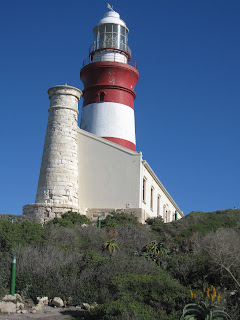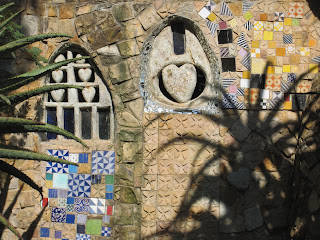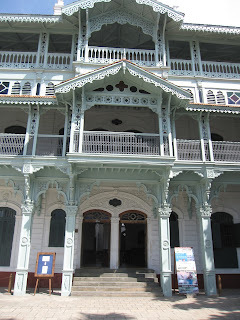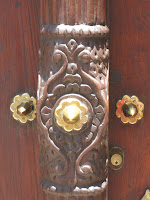The western cape of South Africa is seductive and while we went back to some familiar haunts we also explored new areas, including three historic villages, two of which remain essentially unchanged and continuously inhabited. It was mid-winter and although fairly cool, we only had half a day of rain - and almost no tourists.
What I did on my winter vacation
Now if it had been diet coke cartons it might be a different story.
In addition to our standby activities - "We enjoy candlelit dinners and walks on the beach" -
we discovered some new, off the beaten path sites. Three of the most interesting were the District Six Museum, a musuem housed in an old church on the site of a resettlement area; the Bo-Kaap District; and the Christian Barnard Heart Musuem. District Six was historically a "colored" area that incorporated many ethnicities and racial mixes, somewhat similar to Harlem in that it was a vibrant neighborhood rich with music, art, and a strong sense of belonging. As Cape Town developed so did the need for white neighborhoods and a "resettlement" program was instituted and later accelerated by apartheid. Residents were moved far out of the city and a once cohesive neighborhood now splintered into warring factions and racial groups. Ironically, the cleared land was never rebuilt.
The Bo-Kaap area starts at the edge of the City Center and climbs up Signal Hill at the far end of Table Mountain. It is populated largely by descendants of the Cape Town's original Muslim slaves. It is undergoing renewed interest because of its prime location, although whether this will prove to be a a positive or a negative thing for current residents remains to be seen. It is characterized by its colorful houses, historical architecture, and a small museum.
A brief reference in a guidebook to the "site of the first heart transplant" caught my eye. Both of us clearly remember when this happened and decided it was a must-see. It is housed in the original hospital in a residential neighborhood and provides an excellent overview of the history, research and circumstances leading to the first transplant operation, as well its ensuing publicity, controversy, and consequences. It includes background information on the donor and the first transplant patient and a comprehensive look of the technology of the time. For a Health Channel junkie, this was nirvana.
We also took a day and visited the Kirstenbosch Botanical Gardens. To call these botanical gardens is to call the Redwoods a forest preserve. Well, almost. It covers an extensive area up the slope on the back side of Table Mountain that incoporates a wide variety of flora and hiking trails. We even discovered a back hiking route to the top of the mountain.
It's a small, small world
One of our last nights in Cape Town we had made reservations to eat at one of our favorite restaurants. There was a couple seated at the table behind us, only the man's back visible to me. We could hear bits and pieces of conversation, notable because it was clearly Americans. One of the voices was disturbingly familiar. I kept saying "I know that voice". So Carl was discreetly trying to lean to one side and I was discreetly trying to lean the other hoping to catch a glimpse. Turns out it was someone from my Falls Church book club and her husband. She had not told me she was coming as it would be like telling someone visiting New York to stop by and see someone in Colorado. It was a wonderful surprise and a highlight of the trip for me (or perhaps a measure of my desperation for adult conversation and political discussion?)
Perusing the wine list and other amusements
 And we were off. Our road trip was determined by my love of history and our mutual love of wine, punctuated by a stop at the actual southernmost point of the continent, Cape L'algulhas. The history came from two old villages and the wineries from our new favorite wines.
And we were off. Our road trip was determined by my love of history and our mutual love of wine, punctuated by a stop at the actual southernmost point of the continent, Cape L'algulhas. The history came from two old villages and the wineries from our new favorite wines.
First stop, Vergenoud, an historic working winery and homestead now open to the public. This is not a homestead in the "go west young man" sense. Think plantation on steroids. Acquired originally under nefarious circumstances, it is nonetheless beautiful and showcases a number of buildings in the Cape Dutch style. And the wine ain't bad.
 Next, Arniston, a seasonal beach community and the working fishing village of Kassebai. The dwellings date back 200 years plus and are still inhabited. They gave been declared a national monument.
Next, Arniston, a seasonal beach community and the working fishing village of Kassebai. The dwellings date back 200 years plus and are still inhabited. They gave been declared a national monument. And on to the real southern tip - the Cape L'Agulhas - and not as previously reported from last year's trip - the Cape of Good Hope. It is a desolate, cold and windy but fascinating point of land. It is also an up and coming area for wineries. And the wine ain't bad.
And on to the real southern tip - the Cape L'Agulhas - and not as previously reported from last year's trip - the Cape of Good Hope. It is a desolate, cold and windy but fascinating point of land. It is also an up and coming area for wineries. And the wine ain't bad.
We climbed, literally, the lighthouse. And we paid to do it!

We then continued on and up to the toward the northeast corner of the Western Cape. The Western Cape is like a microcosm of the U.S. in terms of the variety of the topography and vegetation. Heading north the land was defined by big sky and sheep.
Our trip included stops at wineries, a couple nights in the town of Stellenbosch, the wine area of Robertson, and two historical villages, Elim and Tulbaugh. Elim is an old Moravian community established in 1824, still limited to those who follow its religion and relatively unchanged in construction. It is notable in that it housed freed slaves and the legacy of the Moravian/native black mix is evident in the descendants. It is fairly isolated and the population fairly small on a year-round basis and definitely shows its age. Tulbaugh was destroyed in an earthquake in 1969. Many of the historic buildings were destroyed and and since restored. Both are wine country areas as well. And the wine ain't bad.

Wish there was more to show and tell from Maputo. Work continues at a frenzied pace on the road in front of our residence. I am sure somewhere, somehow there is a master plan but it is not evident on a daily basis. Sometimes they have have someone directing traffic, sometimes they don't. Sometimes you can drive both ways, sometimes you can't. Sometimes they cut the water and power lines, sometimes they don't. They grade the road then come back and dig a channel through the middle. There is no linear thinking, only a roller coaster ride of loops and turns. One night we came home in the dark and could not find the driveway. We had to park and walk back. A pile of dirt had been dumped on a neighboring driveway and that was now our entry point. Four wheel drive is not just for the game parks...
Carl did get to meet President and Chelsea Clinton. He was in Maputo to discuss his Foundation with the President of Mozambique and wise enough not enough not to spend the night. A small group went to the airport and met with him briefly in the President's personal lounge. Carl had to wear a suit and everything. Thought President Clinton was quite engaging but that he looked like he had aged quite a bit. And he had only been in Maputo for less than a day.
We continue to learn about the history and current events of southern Africa and look to how this piece of the world puzzle affects our daily lives, the lives of its inhabitants and its impact and implications for the U.S. and others, and most importantly, its future. It is a different paradigm and certainly a challenge for Type A persons who rely on logic and deductive reasoning. If I return thinking in circles, it may not be just a factor of old age.
We continue to learn about the history and current events of southern Africa and look to how this piece of the world puzzle affects our daily lives, the lives of its inhabitants and its impact and implications for the U.S. and others, and most importantly, its future. It is a different paradigm and certainly a challenge for Type A persons who rely on logic and deductive reasoning. If I return thinking in circles, it may not be just a factor of old age.








































































